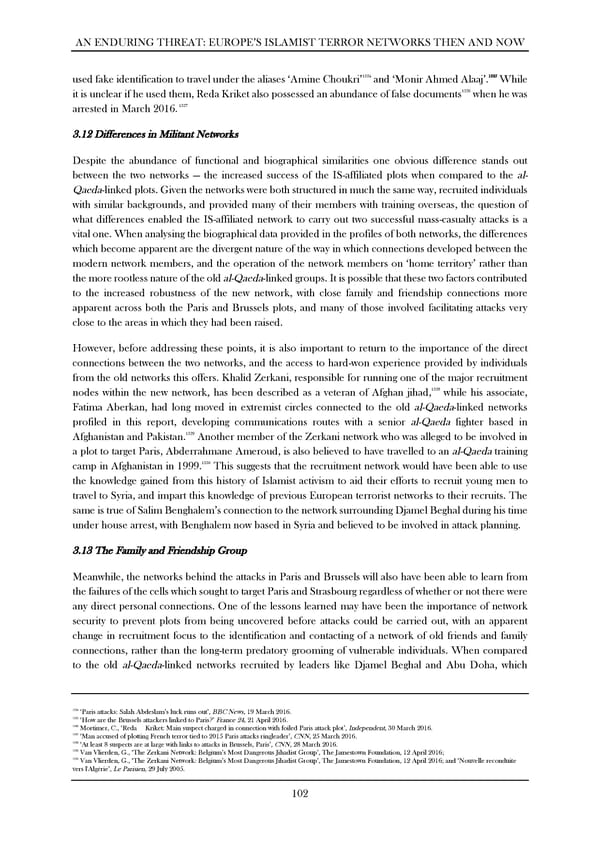AN ENDURING THREAT: EUROPE’S ISLAMIST TERROR NETWORKS THEN AND NOW 1324 1325 used fake identification to travel under the aliases ‘Amine Choukri’ and ‘Monir Ahmed Alaaj’. While 1326 it is unclear if he used them, Reda Kriket also possessed an abundance of false documents when he was 1327 arrested in March 2016. 3.12 Differences in Militant Networks Despite the abundance of functional and biographical similarities one obvious difference stands out between the two networks — the increased success of the IS-affiliated plots when compared to the al- Qaeda-linked plots. Given the networks were both structured in much the same way, recruited individuals with similar backgrounds, and provided many of their members with training overseas, the question of what differences enabled the IS-affiliated network to carry out two successful mass-casualty attacks is a vital one. When analysing the biographical data provided in the profiles of both networks, the differences which become apparent are the divergent nature of the way in which connections developed between the modern network members, and the operation of the network members on ‘home territory’ rather than the more rootless nature of the old al-Qaeda-linked groups. It is possible that these two factors contributed to the increased robustness of the new network, with close family and friendship connections more apparent across both the Paris and Brussels plots, and many of those involved facilitating attacks very close to the areas in which they had been raised. However, before addressing these points, it is also important to return to the importance of the direct connections between the two networks, and the access to hard-won experience provided by individuals from the old networks this offers. Khalid Zerkani, responsible for running one of the major recruitment 1328 nodes within the new network, has been described as a veteran of Afghan jihad, while his associate, Fatima Aberkan, had long moved in extremist circles connected to the old al-Qaeda-linked networks profiled in this report, developing communications routes with a senior al-Qaeda fighter based in 1329 Afghanistan and Pakistan. Another member of the Zerkani network who was alleged to be involved in a plot to target Paris, Abderrahmane Ameroud, is also believed to have travelled to an al-Qaeda training 1330 camp in Afghanistan in 1999. This suggests that the recruitment network would have been able to use the knowledge gained from this history of Islamist activism to aid their efforts to recruit young men to travel to Syria, and impart this knowledge of previous European terrorist networks to their recruits. The same is true of Salim Benghalem’s connection to the network surrounding Djamel Beghal during his time under house arrest, with Benghalem now based in Syria and believed to be involved in attack planning. 3.13 The Family and Friendship Group Meanwhile, the networks behind the attacks in Paris and Brussels will also have been able to learn from the failures of the cells which sought to target Paris and Strasbourg regardless of whether or not there were any direct personal connections. One of the lessons learned may have been the importance of network security to prevent plots from being uncovered before attacks could be carried out, with an apparent change in recruitment focus to the identification and contacting of a network of old friends and family connections, rather than the long-term predatory grooming of vulnerable individuals. When compared to the old al-Qaeda-linked networks recruited by leaders like Djamel Beghal and Abu Doha, which ! ! 1324 ‘Paris attacks: Salah Abdeslam’s luck runs out’, BBC News, 19 March 2016. 1325 ‘How are the Brussels attackers linked to Paris?’ France 24, 21 April 2016. 1326 Mortimer, C., ‘Reda Kriket: Main suspect charged in connection with foiled Paris attack plot’, Independent, 30 March 2016. 1327 ‘Man accused of plotting French terror tied to 2015 Paris attacks ringleader’, CNN, 25 March 2016. 1328 ‘At least 8 suspects are at large with links to attacks in Brussels, Paris’, CNN, 28 March 2016. 1329 Van Vlierden, G., ‘The Zerkani Network: Belgium’s Most Dangerous Jihadist Group’, The Jamestown Foundation, 12 April 2016; 1330 Van Vlierden, G., ‘The Zerkani Network: Belgium’s Most Dangerous Jihadist Group’, The Jamestown Foundation, 12 April 2016; and ‘Nouvelle reconduite vers l'Algérie’, Le Parisien, 29 July 2005. ! ! 102 !
 An Enduring Threat: Europe’s Islamist Terror Networks Then and Now Page 106 Page 108
An Enduring Threat: Europe’s Islamist Terror Networks Then and Now Page 106 Page 108